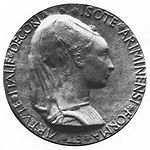- Isotta degli Atti
-
Isotta degli Atti (née v. 1432 à Rimini et morte en 1474) est une noble Italienne du XVe siècle. Elle fut la troisième épouse de Sigismond Malatesta.
Biographie
Elle est la fille de Francesco degli Atti, famille de riches marchands de Sassoferrato de la région des Marches.
Sa branche familiale arrive à Rimini au XIVe siècle sans oublier leur ville natale, ils auraient envoyé le magnifique crucifix de l'École de Rimini qui se trouve encore en l'église de Saint François dans le château de Sassoferrato.
Elle fut présentée à Sigismond Malatesta alors qu'elle avait douze ou treize ans. Elle devint rapidement son amante et lui donna un fils en 1447 nommé Jean qui décéda quelques mois après. Après la mort de Polyxène Sforza, la deuxième épouse, en 1449, le mariage est célébré en 1456. Alors que les mariages précédant étaient infiniment politique, celui-ci semble différent.
Sigismond fit célébrer son amour pour Iseult par des poètes et autres artistes de cour dans une célébration collective qui se pérennisera comme littérature d'Iseult[1].
Ils eurent plusieurs autre enfants :
- Salluste;
- Vittorio;
- Roberto qui épousa Elisabetta di Montefeltro.
Isotta gouverna Rimini car Sigismond étant excomunié par le pape Pie IIe (1461) qui l'accusait d'avoir assassiné ses deux femmes Genévra et Polyxène, ainsi de nombreuses autres personnes avait du quitter la ville. Sigismond meurt en 1468 et son fils. Elle est enterrée en 1474 au Temple Malatesta.
Isotta a été aussi une source d'inspiration pour Ezra Pound[2].
Notes et références
- Cfr. A. Falcioni, 2005
- Lawrence S. Rainey, Ezra Pound and the monument of culture: text, history, and the Malatesta cantos, University of Chicago Press, 1991, (ISBN 0226703169)
Source de traduction
- (it) Cet article est partiellement ou en totalité issu de l’article de Wikipédia en italien intitulé « Isotta degli Atti » (voir la liste des auteurs)
Catégories :- Naissance à Rimini
- Personnalité de la Renaissance
- Personnalité italienne du XVe siècle
- Noblesse italienne
- Personnalité féminine italienne
- Personnalité féminine du XVe siècle
- Renaissance italienne
- Naissance en 1432
- Décès en 1474
Wikimedia Foundation. 2010.

